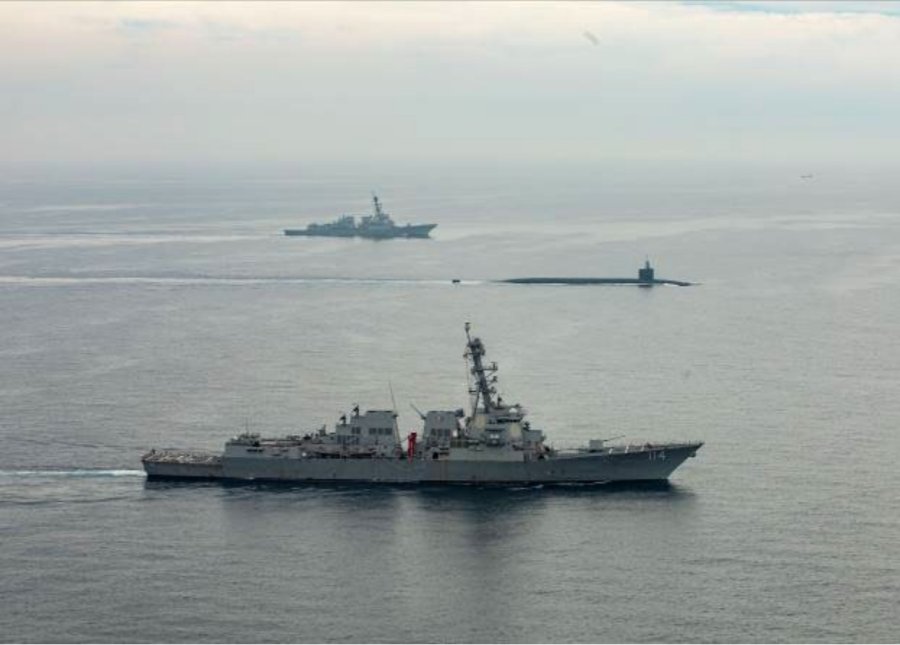July 19, 2023
SEOUL – The US Navy’s nuclear-capable ballistic missile submarine entered Busan in South Korea on Tuesday afternoon, on the day the allies officially launched a new nuclear consultative group to develop scenarios and response protocols in the event of a North Korean nuclear attack on the Korean Peninsula.
US National Security Coordinator for the Indo Pacific Affairs Kurt Campbell made a surprise announcement after the inaugural meeting of the Nuclear Consultative Group, or NCG, took place at the South Korean presidential office in Seoul on Tuesday amid North Korea’s ongoing saber-rattling and bellicose rhetoric.
The bilateral meeting occurred around three months after South Korean President Yoon Suk Yeol and US President Joe Biden agreed to establish the NCG by signing the April 26 Washington Declaration. The US pledged to dispatch a nuclear-capable ballistic missile submarine to South Korea is part of the declaration to further enhance the “regular visibility” of US strategic assets on the Korean Peninsula.
“As we speak, an American nuclear submarine is making port in Busan today, that’s the first visit by an American nuclear submarine in decades,” Campbell, who serves as the chief delegate for the inaugural NCG meeting, said during a joint news conference following the NCG meeting.
Campbell underscored that the rare deployment of the nuclear submarine demonstrated extended deterrence, which is the US’ commitment to deter or respond to coercion and external attacks on US allies and partners with the full range of its military capabilities, including nuclear weaponry.
It is the first deployment of the US submarine — which is capable of launching ballistic missiles with nuclear warheads — in Korea since the early 1980s.
South Korea’s Defense Ministry also confirmed the entry of the Ohio-class ballistic-missile submarine USS Kentucky (SSBN 737) after the NCG meeting.
The carefully timed dispatch comes as the allies “highlighted that any nuclear attack by the DPRK against the ROK will be met with a swift, overwhelming, and decisive response” in the joint statement issued after the meeting.
DPRK stands for the Democratic People’s Republic of Korea, which is North Korea’s official name. ROK stands for the Republic of Korea, which is South Korea’s official name.

The USS Kentucky (C), a nuclear-powered ballistic missile submarine, enters the South Korean naval base in Busan, 320 kilometers southeast of Seoul, on July 18, 2023, in this photo provided by the U.S. Forces Korea. (Yonhap)
Kim Tae-hyo, the first deputy director of South Korea’s National Security Office, also said the allies will collectively enhance extended deterrence in response to escalating North Korean threats, reaching a level where there is no need for South Korea to consider the development of its own nuclear weapons.
“We’ve gained confidence that South Korea and the United States will be able to sufficiently and decisively strengthen extended deterrence to a degree where the need for independent nuclear armament becomes unnecessary,” Kim said during the news conference following the meeting, where he attended as the chief delegate.
The NCG was formed with the goal of strengthening the viability of extended deterrence. But it holds greater significance as it aims to facilitate South Korea’s participation in activities such as sharing information, nuclear and strategic planning, and collaborative decision-making.
As the outcome of the first meeting, Seoul and Washington have reached an agreement on the specific role of the NCG.
“Both sides affirmed that the NCG will play an integral role in discussing and advancing bilateral approaches, including guidelines, to nuclear and strategic planning and responses to DPRK aggression,” the joint statement read.
Speaking at the news conference, Kim said Seoul and Washington would “now progress toward an integrated extended deterrence framework, where South Korea and the US will jointly discuss and decide through the NCG, enabling them to take coordinated action together.”
Kim underscored that the allies agreed to utilize NCG as a venue for the allies to develop and flesh out scenarios that outline the potential use of the US’ nuclear arsenal in response to a North Korean nuclear attack.
“Additionally, both sides have agreed to expand the sharing of information on nuclear and conventional forces and establish a system and procedures that enable bilateral agreements between the leaders of South Korea and the United States in any nuclear crisis situation,” Kim said.

President Joe Biden and President (left) of the Republic of Korea Yoon Suk Yeol review the troops during the Official State Arrival Ceremony, Wednesday, April 26, 2023, on the South Lawn of the White House. (Photo – White House)
Both the South Korean and US sides have made a commitment to pursue collaborative planning and execution of strategies for South Korea’s conventional support to US nuclear operations, according to Kim. To achieve this, the NCG will play a central role in coordinating and conducting various tabletop exercises and simulations related to nuclear scenarios.
The NCG will convene on a quarterly basis at suitable levels, and the subsequent high-level meeting is scheduled to occur later this year in the United States.
When questioned about the possibility of the NCG developing into a trilateral framework involving Japan, Campbell clarified that the current primary focus is on the intensive bilateral engagement between the United States and South Korea. While there may be potential for future endeavors, he emphasized the importance of concentrating on the existing bilateral efforts before considering the expansion to a trilateral framework.
While briefly attending the inaugural NCG meeting, President Yoon placed significant emphasis on the crucial role of the NCG in formulating a “robust response” to the escalating nuclear and missile threats posed by North Korea, presidential spokesperson Lee Do-woon said.
“As President Biden warned in April that North Korea’s nuclear attacks will lead to the end of the regime, we must enhance the viability of extended deterrence by leveraging our nuclear-based alliance to ensure that North Korea does not dare to use nuclear weapons,” Yoon was quoted as saying.


